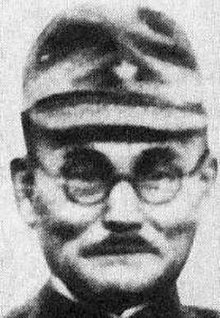Inoue Sadae
Inoue Sadae ( Japanese 井上 貞 衛 ; born November 5, 1886 in Kumamoto Prefecture , Japan ; † October 26, 1961 ) was a Lieutenant General in the Imperial Japanese Army .
Life
Inoue Sadae, born in Kumamoto Prefecture, was the third son of a police officer. After attending a military elementary school, he attended the Imperial Japanese Army Academy , which he graduated in 1908. He took part in the Siberian Intervention with the 44th Infantry Regiment . After the beginning of the Second Sino-Japanese War he was appointed commander of the 5th Infantry Regiment. In the following years he rose quickly through the ranks and was finally promoted to major general in March 1939 and appointed commander of the 33rd Division . From 1941 he served on the staff of the headquarters of the Taiwan Army . After being promoted to Lieutenant General in 1942, Inoue became commander of the 69th Division stationed in China .
In 1943 he was transferred to the same position in the 14th Division , which was stationed on the territory of the Japanese puppet state of Manchukuo . With the increasingly worse situation of Japan in the Pacific War , the need for troops outside of China grew steadily, so that Inoue and his 14th Division were placed under the Southern Army and tasked with the defense of Palau . Both Inoue and the General Staff, which had ordered the defense, were aware that the 14th Division would not be able to successfully defend Palau because of the Allied superiority in men and material. The Japanese leadership hoped, however, that a defense to the last man could weaken the Allies so much that their advance would be significantly slowed.
The 14th Division eventually took part in the Battle of the Palau Islands and the Battle of Peleliu . Although the division was worn out in the process, it could inflict disproportionately high losses on the Allies, as Inoue deviated from the Japanese tactics of head-on suicide attacks and tried to wage a war of attrition taking advantage of the terrain.
After the surrender of Japan Inoue was on Guam detained and for war crimes accused of Class B and C. In 1949, he was sentenced to death by a military tribunal for not exercising his command sufficiently and thus enabling his subordinates to execute three shot down Allied pilots who had been captured on Palau. In 1951, the sentence was commuted to life imprisonment and Inoue was finally released early in 1953.
Individual evidence
- ↑ Bloody beaches - The Marines at Peleliu ( Memento from March 15, 2010 in the Internet Archive )
- ↑ Ammenthorp, database of the generals of World War II
- ^ Ross, Peleliu: Tragic Triumph
- ^ International Journal of Naval History
literature
- James H. Hallas: The Devil's Anvil: The Assault on Peleliu. Praeger Publishers, 1994, ISBN 0-275-94646-0 .
- Saburo Hayashi: Kogun: The Japanese Army in the Pacific War. The Marine Corps Association, Quantico 1959
- Samuel Eliot Morison : Leyte: June 1944 - Jan 1945. in Issue 12 of History of United States Naval Operations in World War II, Little, Brown and Company, 1958, ISBN 0-316-58317-0 .
- Bill D. Ross: Peleliu: Tragic Triumph. Random House, 1991, ISBN 0-394-56588-6 .
Web links
- Inoue Sadae in the database of generals of World War II . Retrieved December 28, 2010.
- International Journal of Naval History . Retrieved December 2, 2014.
| personal data | |
|---|---|
| SURNAME | Inoue, Sadae |
| ALTERNATIVE NAMES | 井上 貞 衛 (Japanese) |
| BRIEF DESCRIPTION | General of the Imperial Japanese Army |
| DATE OF BIRTH | November 5, 1886 |
| PLACE OF BIRTH | Kumamoto Prefecture , Japanese Empire |
| DATE OF DEATH | October 26, 1961 |
